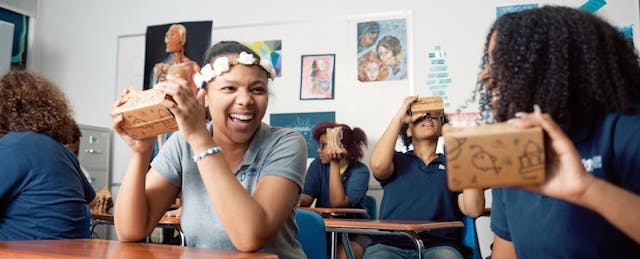Google Classroom currently has more than 10 million active student users, according to Jonathan Rochelle of the Google EDU team—which means that one in six classrooms in the United States use it, he says.
But apparently 10 million isn’t enough for Google.
Just in time for the annual ISTE conference, Google Education is expanding its offerings in the form of three announcements, opening up products including Expeditions to anyone with a device and an interest in learning. Curious about virtual reality? Frustrated with how limiting your classroom projector is? Read below.
1. The Expeditions App—For Everyone
Back in September of 2015, Google launched its beta Expeditions Pioneer Program in order to test the use of virtual reality (VR) in classrooms. Until now, taking these virtual Google field trips was only something that a select number of school “partners” could take part in.
But today, Google has launched the free Expeditions app on the Google Play store and over 200 Expeditions (from national parks to the U.S. Museum of National History) for students and teachers to choose from.
According to Expeditions Product Manager Ben Schrom, Google created these virtual excursions because “chemistry labs and school buses (for field trips) simply don’t scale very well,” while “widely accessible VR is a chance to dramatically scale experiential learning” by taking students outside of the classrooms.

Schrom reports that each Expedition is a set of VR scenes annotated with facts and sites for the “Guide” (i.e. teacher), shown above, to reference while students engage with the experience. Shrom also shares that he and his team are continuing to create more Expeditions through partnerships with Getty Images, Associated Press, Pearson and Houghton Mifflin Harcourt.
Google reports that the app is available today for Android, and will be available for iPhones and iPads later this year.
2. Projecting With ‘Cast for Education’
Today, Google is also beta-launching ‘Cast for Education,’ a free Chrome app that gives anyone in a classroom—students and teachers—the ability to share their screen wirelessly from their device.
Product manager Max Kirsch says that in their research, he and his team have found that classroom projectors are one of the most commonly-used devices in classrooms. “But we’ve noticed that the projector is still disconnected from the rest of the class,” he adds, sharing that Cast is his team’s attempt to bridge that disconnect.

With Cast, students can now project their screens (from any wireless connection, even if they’re on different networks) in front of the classroom and share their work with the rest of the class. The app integrates with Google Classroom, so that upon logging into the Cast app, teachers invite students on Classroom to share their work. Erin Turnbach,a 2nd grade teacher, piloted Cast in her New Jersey classroom and describes the experience:
“One group was researching frogs. ‘That is a great piece of evidence,’ I said. ‘Can you cast your screen to show everyone where to find that type of fact?’”
Given the flurry of articles and movement around personalized learning, one might wonder: this Cast feature seems to still keep attention at the front of the classroom. Isn’t it perpetuating the ‘sage on the stage’ approach to teaching?
Kirsch explains that in his observations, Cast has actually freed teachers up to give individual students attention: “What we’ve found from the pilot teachers is that they’re able to walk around, and talk to students while they’re working.”
3. Quizzes in Google Forms
Last but not least, Google Education has announced a quiz feature in Google Forms, where educators can generate quizzes that Forms will auto-grade.

The feature sends feedback immediately to the student in the form of exit tickets or monthly assessments, which the teacher can supplement with websites or review videos to help the student relearn a concept. And because teachers can see student performances from a whole-class view, they can identify frequently-missed questions and garner insights into what concepts they should review again with all students.
4. Project Bloks
Google Creative Lab has released Project Bloks, a toy that allows students to build circuits and learn to code. The research arm of the search giant partnered with design firm IDEO to create a toy that comes in three parts: the "brain board," the "base board" and the "pucks." Students join the three together to program small machines. The brain board connects to other devices via wifi and bluetooth, and the base boards serve as brain board connectors and platforms for the pucks, which pass on commands to connected devices around the classroom. The pucks give simple instructions such as "turn 180 degrees" or "repeat the following actions." The team has published a whitepaper explaining the project in detail.


